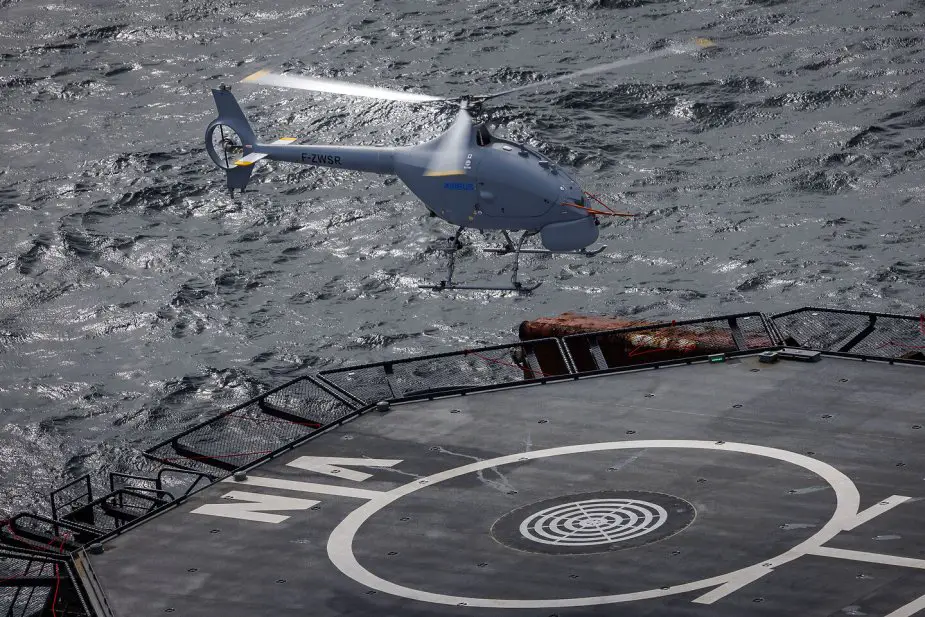Breaking news
Airbus & French DGA tests VSR700 UAS in operational configuration for first time.
According to a PR published by Airbus on May 15, 2023, Airbus Helicopters and the French Armament General Directorate (DGA) tested the unmanned aerial system (UAS) VSR700 for the first time in an operational configuration from a ship at sea.
Follow Navy Recognition on Google News at this link
 VSR700 in operational configuration with a French Navy ship. (Picture source: Airbus)
VSR700 in operational configuration with a French Navy ship. (Picture source: Airbus)
The VSR700, an unmanned aerial vehicle (UAV), accomplished a significant feat at the start of May when it successfully conducted 80 fully autonomous take-offs and landings from a civil vessel cruising off the coast of Brittany, France. The vessel was equipped with a helicopter deck specifically designed for this purpose.
These impressive operations were a follow-up to tests conducted in 2022, where the autonomous take-off and landing capabilities of the VSR700 were put to trial on the same vessel.
This round of tests involved an optionally piloted vehicle (OPV) that was based on a modified Guimbal Cabri G2 fitted with the autonomous take-off and landing (ATOL) system developed for the VSR700.
The tests were conducted using the SDAM demonstrator, marking a crucial step in the SDAM (Système de Drone Aérien pour la Marine) study that was initiated by Airbus Helicopters and Naval Group in 2017. They effectively validated the capabilities of the system.
Autonomous take-off and landing capabilities, a key feature of the VSR700, were facilitated by the Airbus DeckFinder system. This advanced technology allows for autonomous launch and recovery of UAVs with a precision of 10-20cm even in challenging operations under harsh environmental conditions. It operates independently of GNSS/GPS and is unaffected by degraded visual conditions.
These tests followed two series of trials with the DGA in late 2022 and early 2023, held at the Levant Island test center in southern France. During these trials, the SDAM prototype demonstrated its ability to function efficiently in a maritime environment.
The aircraft's handling qualities were evaluated, along with the capabilities of its maritime surveillance radar, an electro-optical sensor, an AIS receiver, and the mission system developed by Naval Group.
The next development phase will involve the second VSR700 prototype undertaking its inaugural flight, followed by flight testing onboard a French Navy FREMM during the second half of this year.
About the VSR700
The UAV has the capacity to carry a mission payload of 100 kg (220 lb), making it suitable for a variety of operations.
The aircraft's dimensions are as follows: it measures 6.2 m (20 ft 4 in) in length, 1.24 m (4 ft 1 in) in width, and stands 2.28 m (7 ft 6 in) tall. The maximum takeoff weight of the VSR700 is 700 kg (1,543 lb), accommodating its fuel capacity of 185 L (41 imp gal; 49 US gal).
This UAV is powered by a single Thielert Centurion 2.0 diesel engine, which generates 116 kW (155 hp). It features a main rotor with a diameter of 7.2 m (23 ft 7 in), enhancing its flight stability and lift capabilities.
The VSR700 cruises at a speed of 220 km/h (140 mph, 120 kn). It exhibits remarkable endurance, being able to stay airborne for 10 hours, or over 8 hours when it's operating 100 nautical miles (185 km, 115 miles) from its launching boat. This UAV can operate at a service ceiling of 6,000 m (20,000 ft).





























